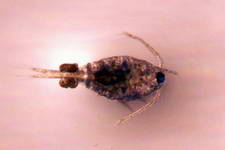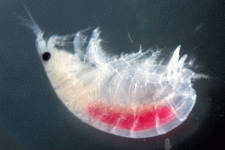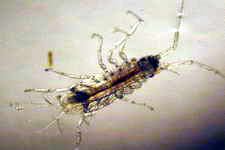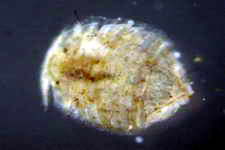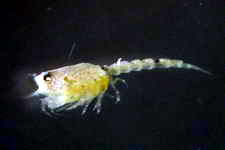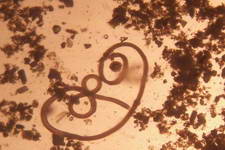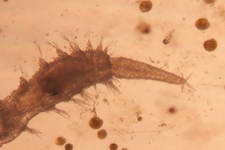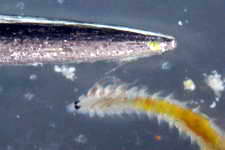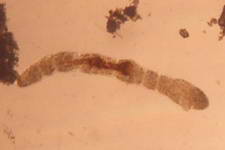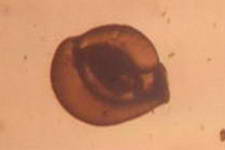

When first establishing a marine aquarium the first inhabitants
added to the system are the members of what is know as the "Clean up
Crew". This crew is almost always comprised of a mixture of snails,
hermit crabs and starfish as recommended by any number of local stores
or those found online.
This article will address what I feel has become a bad habit
within the hobby. The use of species that are not suited for a tropical
rocky habitat and in numbers that far exceed the aquarium's ability to
provide for their needs. Some of this information, if you care to use
it, will require you to be able to identify the various species that
are offered for sale. I will include links to online resources that
will hopefully allow you to do so.
What is a clean up crew?
Most often, a clean up crew is thought of as being but a few herbivores
or scavengers to simply eat algae and clean up left over fish food. I
feel this is an over simplified view and most often does not take into
consideration that we are striving for a Reef aquarium. It is my hope
that by taking the effort to put this together, it will inspire or
guide others to think outside of the coral box. After all, what is a
reef? Surely not a bunch of rocks with some corals parked on top of it
all. I enjoy all the "little people" as much or more than I do the
coral species kept plus the fact that I wish to have an actual
ecosystem that through its various animal and plant members can
maintain itself. Each animal has its part to play in that role and in
combination, makes for an easy to keep reef aquarium with minimal
equipment and effort while providing me with the joy of seeing it all
in action. Being that most all of the inverts and sponges are closer to
the bottom of the food chain than say the corals and fish are, I also
consider these animals to make up what one could call a very extensive
"clean up" crew while providing food for other species as well. Since I
am discussing food chains I need to stress the fact that all food
chains with one exception (deep ocean vents) start at the bottom with
plants or algae. The very item that caused us to consider buying a
clean up crew to begin with. Yet once an aquarium does acquire a diverse
clean up crew, it will most likely need to be supplemented with
phytoplankton to ensure we keep as much diversity as possible. In
short, a clean up crew is a reef !
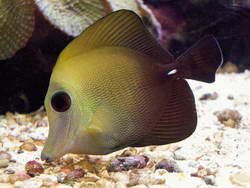 Zebrasoma scopas - The
brown scopas tang, the one fish species that I will always have in any
coral display aquarium where algae must be kept under control.
Zebrasoma scopas - The
brown scopas tang, the one fish species that I will always have in any
coral display aquarium where algae must be kept under control.  The Astraeinae
- Commonly called the Astrae snails. This is as most snail
families are, a very large group containing many species, not all of
which are coral reef inhabitants. The species shown is an Astralium calcar and
is my first choice when looking for herbivores. This species and those
with similarly shaped shells are best suited for our reef aquariums as
their flat shape allows them to easily right themselves should they
topple over. While this specific species may not always be available,
any other species with the same shell shape or design will be suit your
aquarium's needs.
The Astraeinae
- Commonly called the Astrae snails. This is as most snail
families are, a very large group containing many species, not all of
which are coral reef inhabitants. The species shown is an Astralium calcar and
is my first choice when looking for herbivores. This species and those
with similarly shaped shells are best suited for our reef aquariums as
their flat shape allows them to easily right themselves should they
topple over. While this specific species may not always be available,
any other species with the same shell shape or design will be suit your
aquarium's needs.  The Astralium okamotoi ,
has one of the most commonly shaped shells found within the hobby even
though it is not a coral reef inhabitant. The tall coned shaped shells
ensures that should they topple over, they will become firmly wedged in
the rocky landscape and die a slow death if not found and uprighted by
the hobbyist. I never see this species or those shaped like it
out on the coral reefs and are only found within the shallow sea grass
beds keeping the sea grass blades clean of algae growth. Should they
fall off their perch, with the flat terrain and abundant leaf litter,
they easily right themselves.
The Astralium okamotoi ,
has one of the most commonly shaped shells found within the hobby even
though it is not a coral reef inhabitant. The tall coned shaped shells
ensures that should they topple over, they will become firmly wedged in
the rocky landscape and die a slow death if not found and uprighted by
the hobbyist. I never see this species or those shaped like it
out on the coral reefs and are only found within the shallow sea grass
beds keeping the sea grass blades clean of algae growth. Should they
fall off their perch, with the flat terrain and abundant leaf litter,
they easily right themselves.  The
"Turbo" or "Turban" snails, also very commonly sold as suitable for our
aquariums, which they are if they are suitably sized. The species shown
reaches a maximum size of 15mm while other species easily approach
100mm. Not something I would want bulldozing its way through my corals
and landscape. The link I have provided for this family will allow you
to choose the correctly sized species for your aquarium. Shown in
the photo is a Turbo mazatlanicus
, which averages in size between 5 - 15 mm. Again, while this
family of snails are good grazers, their usually large size limits their
usefulness.
The
"Turbo" or "Turban" snails, also very commonly sold as suitable for our
aquariums, which they are if they are suitably sized. The species shown
reaches a maximum size of 15mm while other species easily approach
100mm. Not something I would want bulldozing its way through my corals
and landscape. The link I have provided for this family will allow you
to choose the correctly sized species for your aquarium. Shown in
the photo is a Turbo mazatlanicus
, which averages in size between 5 - 15 mm. Again, while this
family of snails are good grazers, their usually large size limits their
usefulness.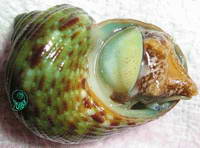 The "DIBS" Turbo snail ( Turbo
argyrostoma. ) - Of all the species of turbo snails, I would recommend this species for quite a few reasons.
The "DIBS" Turbo snail ( Turbo
argyrostoma. ) - Of all the species of turbo snails, I would recommend this species for quite a few reasons. The "Trochus" and other members of this family can be suitable
for our reef aquariums if once again, their shell shape is taken into
account. Some species within this family are much more "squat" than
others that resemble the tall pyramid shapes found within the
Astraeinae family.
The "Trochus" and other members of this family can be suitable
for our reef aquariums if once again, their shell shape is taken into
account. Some species within this family are much more "squat" than
others that resemble the tall pyramid shapes found within the
Astraeinae family. 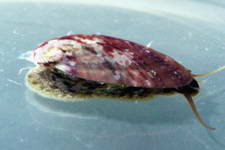 A member of the Trochidae family, Stomatella varia.
Not normally found for sale but is a very common find as a hitch hiker
upon live rock. An excellent herbivore as well as there be many
reports of this snail species reproducing successfully within our
aquariums.
A member of the Trochidae family, Stomatella varia.
Not normally found for sale but is a very common find as a hitch hiker
upon live rock. An excellent herbivore as well as there be many
reports of this snail species reproducing successfully within our
aquariums. 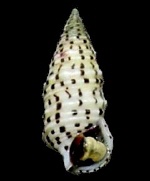 The "Cerith" snails as they are commonly called are another
suitable species for our rocky environments. It is not uncommon to find
members of this family hitch hiking in with live rock and can be
confused for being a predatory whelk. This is where your skill in being
able to identify snail species will come in handy. Shown is a Cerithium punctatum.
The "Cerith" snails as they are commonly called are another
suitable species for our rocky environments. It is not uncommon to find
members of this family hitch hiking in with live rock and can be
confused for being a predatory whelk. This is where your skill in being
able to identify snail species will come in handy. Shown is a Cerithium punctatum.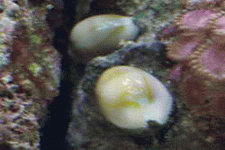 Very few species within this family are strict herbivores. A
great many of them are omnivores, able to switch between algae and more
meatier items such as corals or anemones. I consider the ringed cowry (
Cypraea annulus
) to be the only species suitable for our reef aquariums as it will
readily consume both micro algae and many of the filament (hair) algae
species while remaining small. There are a few other species that
are made available from time to time, but these become very large and
would soon have your landscape laying in the sand.
Very few species within this family are strict herbivores. A
great many of them are omnivores, able to switch between algae and more
meatier items such as corals or anemones. I consider the ringed cowry (
Cypraea annulus
) to be the only species suitable for our reef aquariums as it will
readily consume both micro algae and many of the filament (hair) algae
species while remaining small. There are a few other species that
are made available from time to time, but these become very large and
would soon have your landscape laying in the sand.  The Scutus,
Slowly becoming available in the hobby but most often only found
as a hitch hiker upon live rock purchases. Some species get
fairly large and would most likely not be suitable except for very
large aquariums. The species shown in the photograph remains a small
size and are all excellent algae grazers. One word of caution -
The black species gets quite large and there have been reports of it
feeding on coral tissue once it has eaten all of the algae. The species
shown above remains relatively small and has not been known to become a
problem.
The Scutus,
Slowly becoming available in the hobby but most often only found
as a hitch hiker upon live rock purchases. Some species get
fairly large and would most likely not be suitable except for very
large aquariums. The species shown in the photograph remains a small
size and are all excellent algae grazers. One word of caution -
The black species gets quite large and there have been reports of it
feeding on coral tissue once it has eaten all of the algae. The species
shown above remains relatively small and has not been known to become a
problem.  The Limpets, Belongs to the same family as the Scutus. There are
a few species that can be found on live rock, but the majority of them
are shore line creatures capable of withstanding exposure to air during
low tides. If available, some of the smaller species could be suitable
for our aquariums.
The Limpets, Belongs to the same family as the Scutus. There are
a few species that can be found on live rock, but the majority of them
are shore line creatures capable of withstanding exposure to air during
low tides. If available, some of the smaller species could be suitable
for our aquariums. 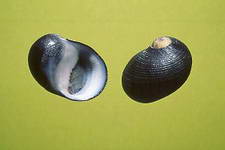 Most Nerites are not suited for aquariums simply because they are
inter tidal, moving above the water line and only returning to the water
to feed upon algae. I doubt that any of the species made available
would be of a suitable species simply because the collectors can easily
gather them by their hundreds near the shallow shore lines.
Most Nerites are not suited for aquariums simply because they are
inter tidal, moving above the water line and only returning to the water
to feed upon algae. I doubt that any of the species made available
would be of a suitable species simply because the collectors can easily
gather them by their hundreds near the shallow shore lines.  The Abalone - Most species within this family are too large for a typical aquarium with one exception. The species Haliotis asinina
, also know as the ass or donkey ear abalone remains relatively small
compared to other members of this group averaging three to four inches
in length. Still a fairly large snail and one that I would only
recommend for the larger aquariums.
The Abalone - Most species within this family are too large for a typical aquarium with one exception. The species Haliotis asinina
, also know as the ass or donkey ear abalone remains relatively small
compared to other members of this group averaging three to four inches
in length. Still a fairly large snail and one that I would only
recommend for the larger aquariums.  The Chitons. A very common hitch hiking find within live
rock. Most species will prove to be harmless grazers and add a unique
animal to your aquariums diversity. I do not know of any sources
for purchase or those who have successfully bred and raised them.
The Chitons. A very common hitch hiking find within live
rock. Most species will prove to be harmless grazers and add a unique
animal to your aquariums diversity. I do not know of any sources
for purchase or those who have successfully bred and raised them.  Free roaming hermit crabs cause more trouble than they are worth
over the long term. There are much safer alternatives for detritus and
left over food clean up.
Free roaming hermit crabs cause more trouble than they are worth
over the long term. There are much safer alternatives for detritus and
left over food clean up. 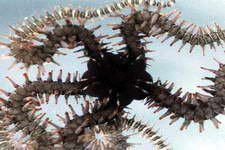 A typical brittle starfish. Such starfish will usually pick a
specific place to settle and will remain there, extending its arms in
search of left over food or detritus while keeping its vulnerable central
disc hidden and safe from predators. The brittle starfish species
can be found in any number of sizes, with most being an average that
makes them suitable for our aquariums. Please see the relevant
section of my hitch hiker pages for more information on starfish
species per their being reef safe or not. A great many species of
brittle starfish find their way into our aquariums as hitch hikers
within live rock and at times, live sand. Caution : Just
as with any marine family group, there are those members that do not
belong in an enclosed aquarium system. The brittle starfish Ophiarachna incrassata (large green species) is a very active predator of fish.
A typical brittle starfish. Such starfish will usually pick a
specific place to settle and will remain there, extending its arms in
search of left over food or detritus while keeping its vulnerable central
disc hidden and safe from predators. The brittle starfish species
can be found in any number of sizes, with most being an average that
makes them suitable for our aquariums. Please see the relevant
section of my hitch hiker pages for more information on starfish
species per their being reef safe or not. A great many species of
brittle starfish find their way into our aquariums as hitch hikers
within live rock and at times, live sand. Caution : Just
as with any marine family group, there are those members that do not
belong in an enclosed aquarium system. The brittle starfish Ophiarachna incrassata (large green species) is a very active predator of fish. 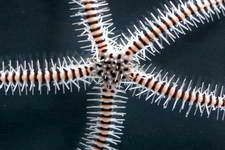 The Mini Brittle Starfish - With the purchase of live sand and
live rock, it is fairly certain that you will obtain any number of very
small species of brittle starfish. Quite a few species will bury
themselves into the sand leaving only their arms extended to catch
passing food particles. It is unknown as to how they reproduce within
our systems but they manage to do so. If you do find yourself
lucky enough to have a large population, I encourage you to share them
with fellow hobbyists.
The Mini Brittle Starfish - With the purchase of live sand and
live rock, it is fairly certain that you will obtain any number of very
small species of brittle starfish. Quite a few species will bury
themselves into the sand leaving only their arms extended to catch
passing food particles. It is unknown as to how they reproduce within
our systems but they manage to do so. If you do find yourself
lucky enough to have a large population, I encourage you to share them
with fellow hobbyists.  Asterina anomal
- Yet another commonly found hitch hiker that can prove to be a
beneficial member of the herbivore clean up crew. With sufficient food
sources, these small starfish can reproduce within our aquariums by
casting off their arms which then form new starfish. Such a
reproductive method is why they appear to have different sized arms at
all times. Caution :
With the Asterina family having hundreds of members, and their
being little studied, you may on the rare occasion find what appears to
be the above mentioned species yet it will be a coral predator. If you
do find what appears to be an Asterina anomal
on a coral, it is best to remove it and all others that look like it.
Again, I want to stress that this is a rare event and do not want to
condemn all like starfish for the bad habits of a few members.
Asterina anomal
- Yet another commonly found hitch hiker that can prove to be a
beneficial member of the herbivore clean up crew. With sufficient food
sources, these small starfish can reproduce within our aquariums by
casting off their arms which then form new starfish. Such a
reproductive method is why they appear to have different sized arms at
all times. Caution :
With the Asterina family having hundreds of members, and their
being little studied, you may on the rare occasion find what appears to
be the above mentioned species yet it will be a coral predator. If you
do find what appears to be an Asterina anomal
on a coral, it is best to remove it and all others that look like it.
Again, I want to stress that this is a rare event and do not want to
condemn all like starfish for the bad habits of a few members. 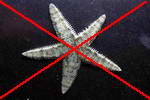 Please note that the so called sand sifting starfish are not
recommended simply because they, through their sifting of the sand are
only doing so in order to find and eat the sand dwelling infauna that
you paid for when you purchased live sand. The same can be said of any
animal that actively sifts the sand such as some goby species.
Please note that the so called sand sifting starfish are not
recommended simply because they, through their sifting of the sand are
only doing so in order to find and eat the sand dwelling infauna that
you paid for when you purchased live sand. The same can be said of any
animal that actively sifts the sand such as some goby species. 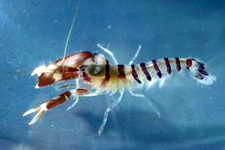 The snapping or pistol shrimp make for an interesting member of
any clean up crew. Although rarely seen once they have established a
burrow system, they do however keep their areas cleaned of any food
particles. Most species that end up as members of our clean up crew
came to us by hitch hiking in with live rock.
The snapping or pistol shrimp make for an interesting member of
any clean up crew. Although rarely seen once they have established a
burrow system, they do however keep their areas cleaned of any food
particles. Most species that end up as members of our clean up crew
came to us by hitch hiking in with live rock.  The Thalassinidean shrimp are also a very frequent find within
live rock. I would wager that a great many aquariums have a
number of these shrimp yet do not know it as they are very cryptic,
remaining forever within their live rock burrows.
The Thalassinidean shrimp are also a very frequent find within
live rock. I would wager that a great many aquariums have a
number of these shrimp yet do not know it as they are very cryptic,
remaining forever within their live rock burrows.  There are some species of sea cucumbers that I avoid simply
because they are quick to expel and could kill my fish. For more
information concerning species selections, please see this link.
While not a complicated animal to care for, there are a few
concerns to take into consideration when adding a sea cucumber to your
aquarium. Not being the quickest or brightest of creatures, any pump
inlet that is not covered or protected will pose a very real danger to
your sea cucumber. Keeping the inlet guards that should have come with
your pump when you purchased it, in place, will prevent any such
accidents from happening.
There are some species of sea cucumbers that I avoid simply
because they are quick to expel and could kill my fish. For more
information concerning species selections, please see this link.
While not a complicated animal to care for, there are a few
concerns to take into consideration when adding a sea cucumber to your
aquarium. Not being the quickest or brightest of creatures, any pump
inlet that is not covered or protected will pose a very real danger to
your sea cucumber. Keeping the inlet guards that should have come with
your pump when you purchased it, in place, will prevent any such
accidents from happening. 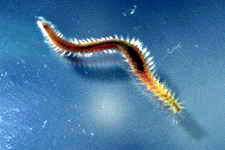 Eurythoe complanata - Probably the most commonly
found worm and is a harmless scavenger, a benefit to our systems. It is
my opinion that these worms are an excellent replacement for the use of
destructive hermit crabs.
Eurythoe complanata - Probably the most commonly
found worm and is a harmless scavenger, a benefit to our systems. It is
my opinion that these worms are an excellent replacement for the use of
destructive hermit crabs. 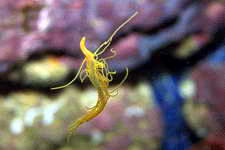 The Cirratulids, or better known as the hair worms. Any
number of species can be found within live rocks and live sand as they
are indirect filter feeders living off of detritus and other small food
particles.
The Cirratulids, or better known as the hair worms. Any
number of species can be found within live rocks and live sand as they
are indirect filter feeders living off of detritus and other small food
particles.  The Terebellidae or spaghetti worms. Yet another common hitch
hiker and one of great benefit as they also inhabit both live rocks and
live sand, only extending their feeding tentacles in search of detritus
and other food particles.
The Terebellidae or spaghetti worms. Yet another common hitch
hiker and one of great benefit as they also inhabit both live rocks and
live sand, only extending their feeding tentacles in search of detritus
and other food particles. 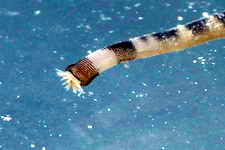 The Sipunculida worms or peanut worms. One of the most
commonly found worms living within live rock extending their feeding
proboscis in search of detritus and left over food particles while
keeping their peanut shaped body hidden within the rock.
The Sipunculida worms or peanut worms. One of the most
commonly found worms living within live rock extending their feeding
proboscis in search of detritus and left over food particles while
keeping their peanut shaped body hidden within the rock.  Elysia crispata -
The Lettuce nudibranch, eats a variety of large algae but seems to
prefer the bryopsis filament algae. A delicate species and should
only be kept by the more experienced hobbyist.
Elysia crispata -
The Lettuce nudibranch, eats a variety of large algae but seems to
prefer the bryopsis filament algae. A delicate species and should
only be kept by the more experienced hobbyist. 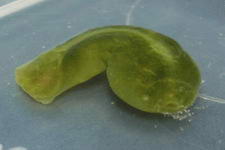 Phanerophthalmus smaragdinus
- This species is an obvious herbivore yet it is unknown if it is
a specialized feeder or not. At this time I do not know of any sources
to purchase these slugs yet they can be found as hitch hikers on rare
occasions.
Phanerophthalmus smaragdinus
- This species is an obvious herbivore yet it is unknown if it is
a specialized feeder or not. At this time I do not know of any sources
to purchase these slugs yet they can be found as hitch hikers on rare
occasions.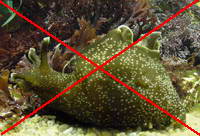 Aplysia punctata -
This Sea Hare is commonly sold and is a species I do not recommend for
our warm tropical aquariums as it is a subtropical to cold water
species.
Aplysia punctata -
This Sea Hare is commonly sold and is a species I do not recommend for
our warm tropical aquariums as it is a subtropical to cold water
species. 